Investigation of the same isomeric pair, produced from different nuclear reactions
The isomeric ratio (IR) of isomeric pair 109m,gPd, produced in 110Pd(γ, n)109m,gCd reaction
and 108Pd(n, γ)109m,gPd neutron capture reactions, induced by thermal, epithermal and mixed
thermal-epithermal neutrons have been determined. The off-line activation technique using a
spectroscopic system consisting of a HPGe semiconductor detector with high energy resolution and
a PC based 8192 channel analyzer (CANBERRA) was applied. The investigated samples were
prepared from the 99.99 % purity PdO and irradiated at the electron accelerator Microtron MT-25
of the Joint Institute for Nuclear Research Dubna, Russia. The data analysis and necessary
corrections were made to upgrade the precision of the experimental method. The obtained results
were discussed, compared and combined with those from other authors to point out the role of the
reaction channels in nuclear reactions.
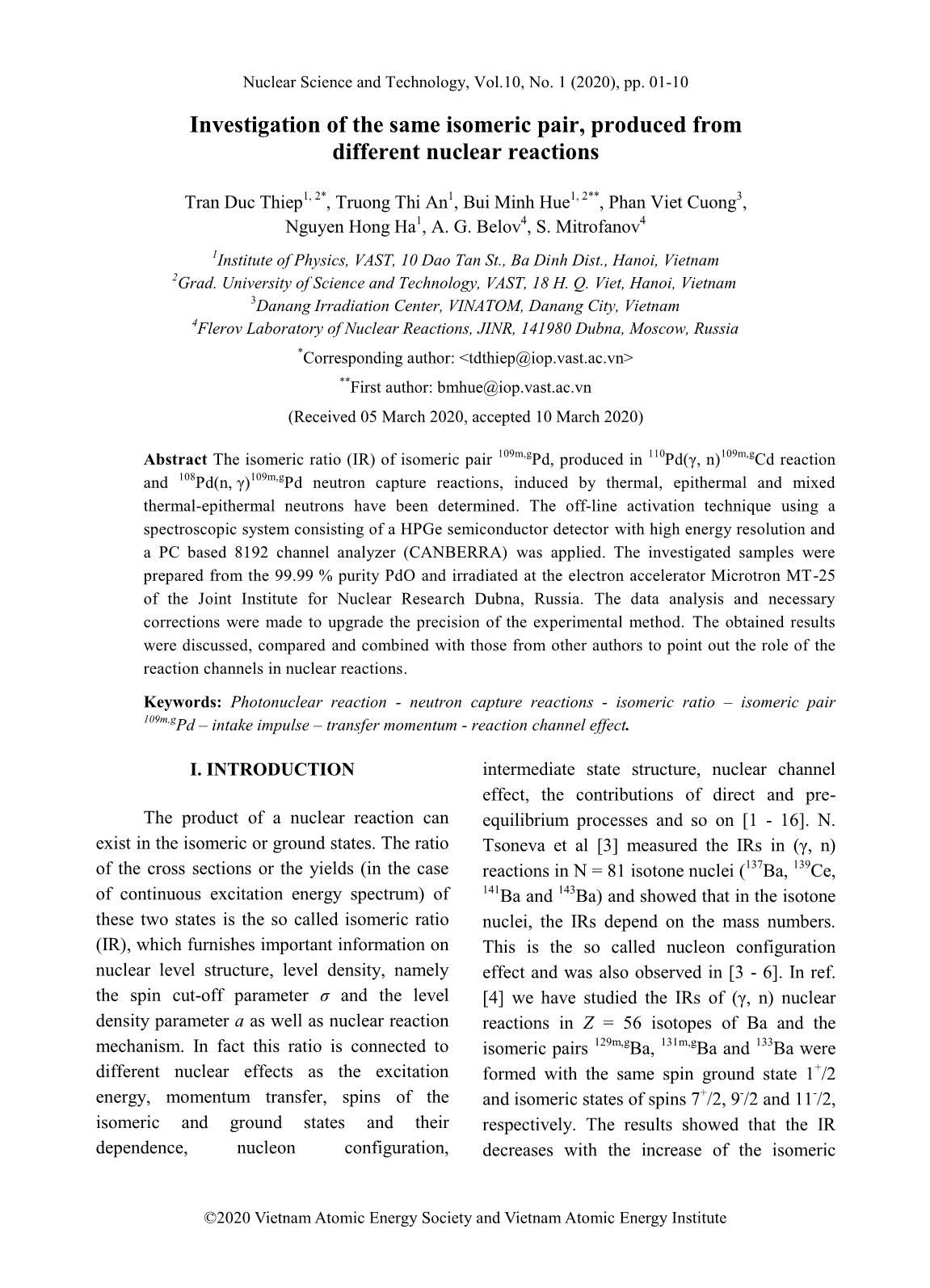
Trang 1
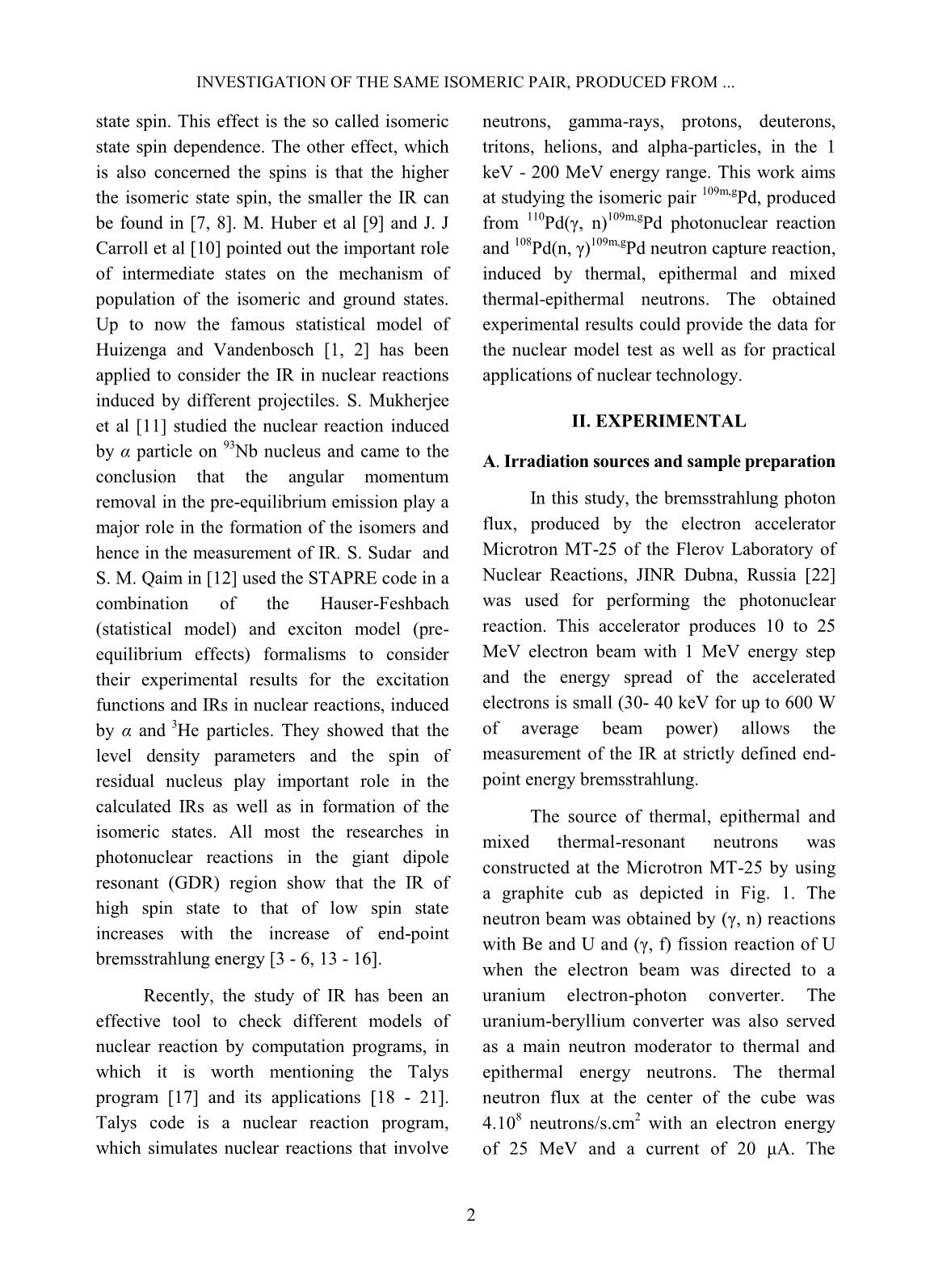
Trang 2
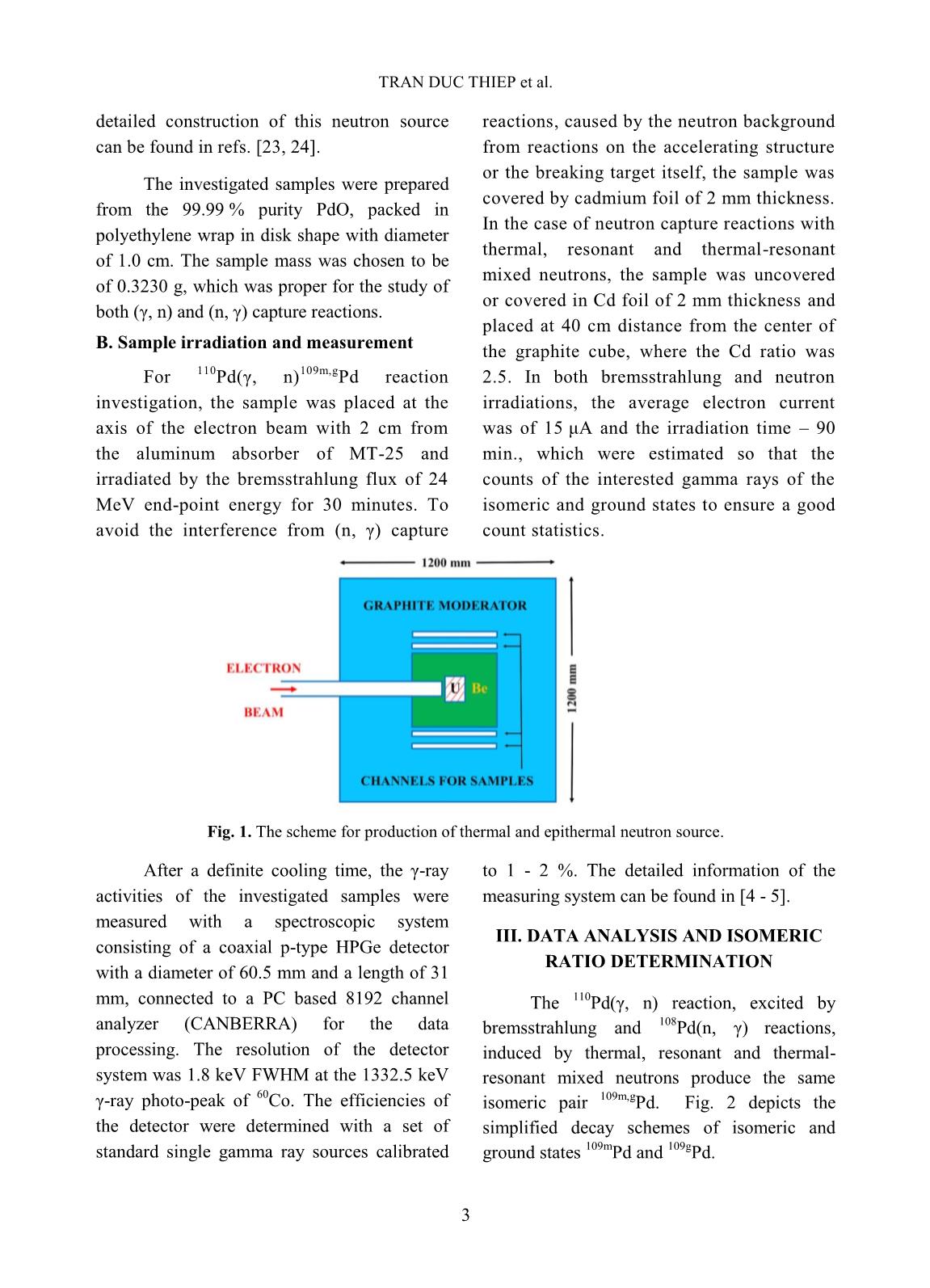
Trang 3
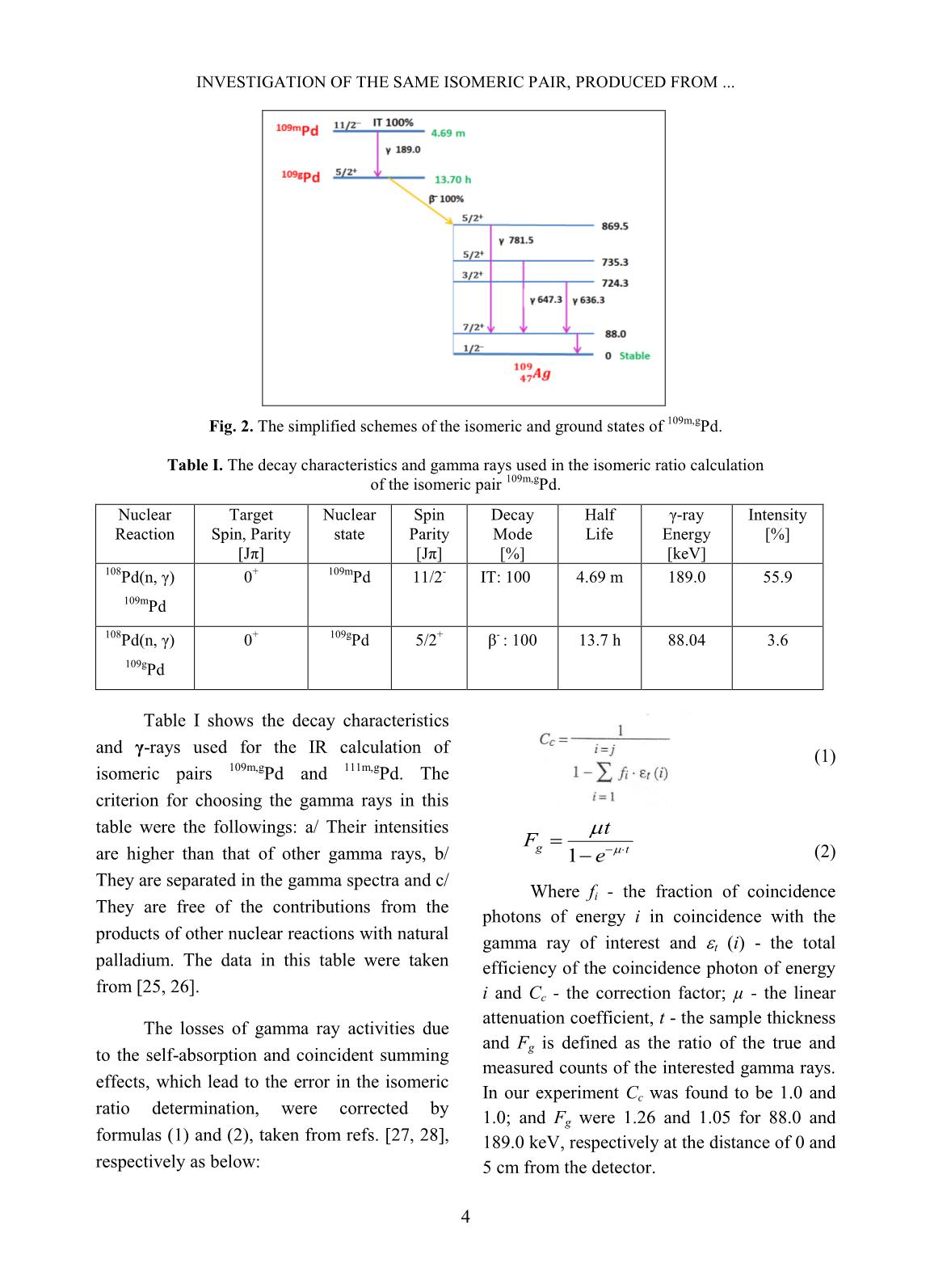
Trang 4
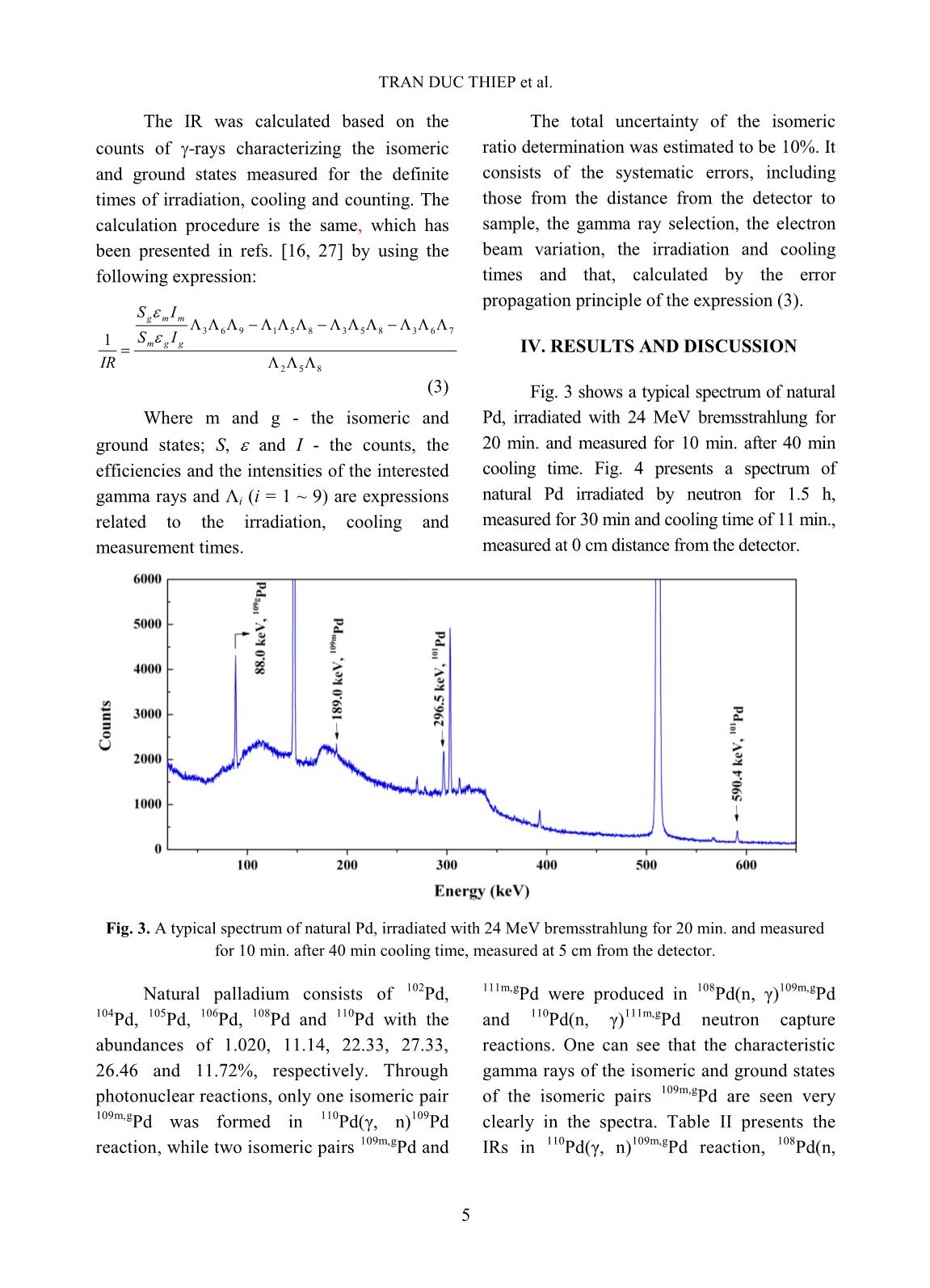
Trang 5
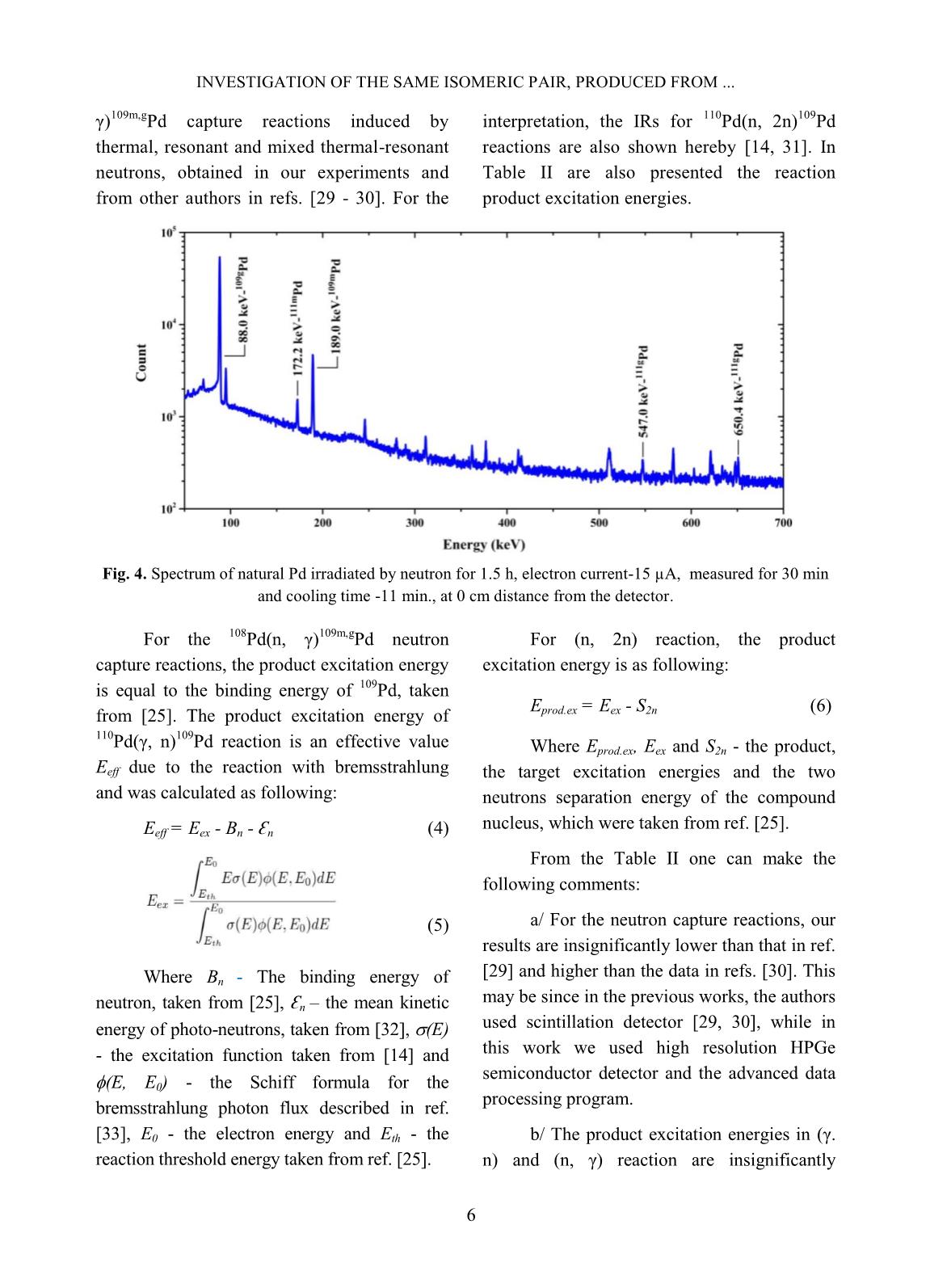
Trang 6
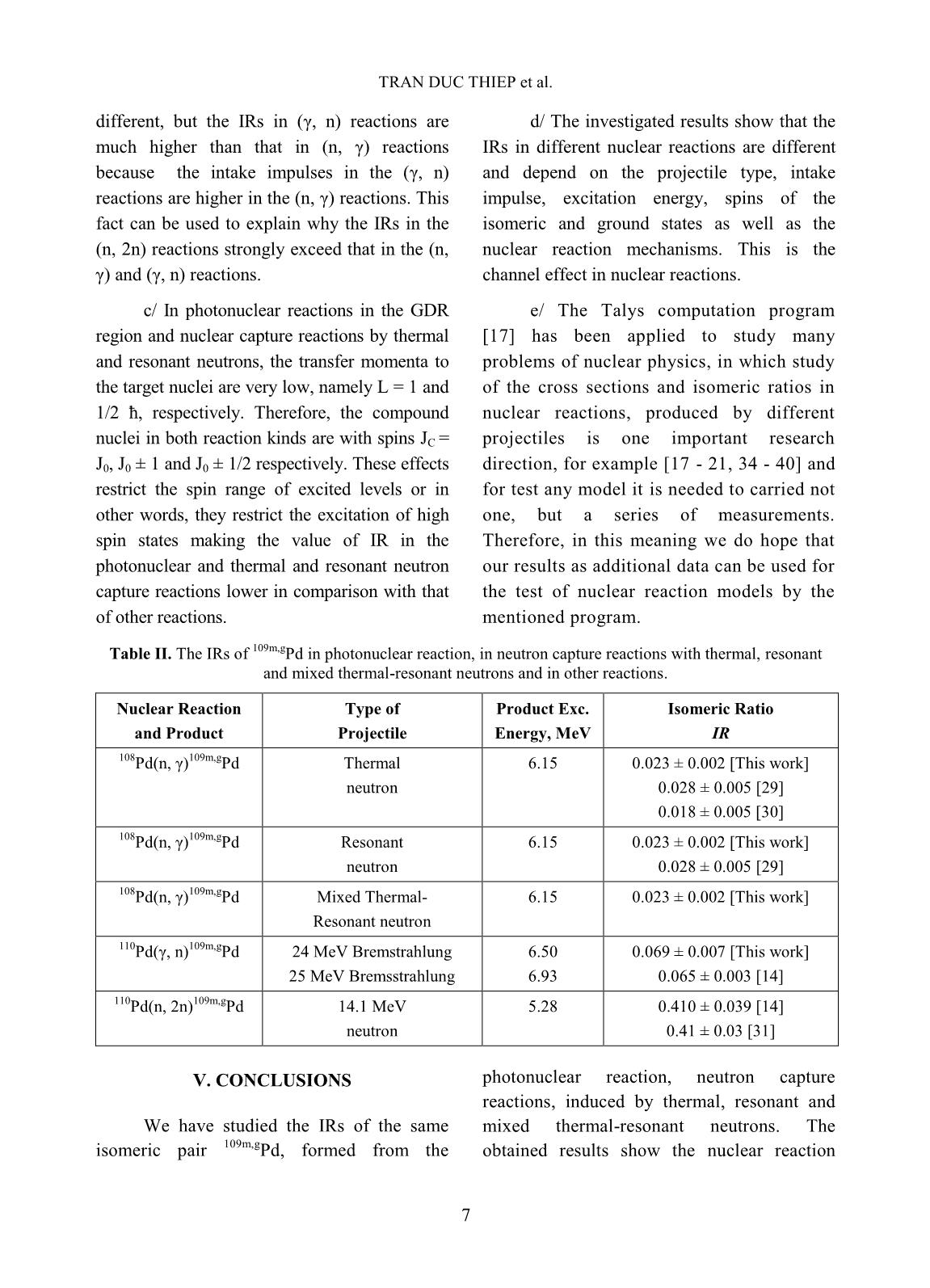
Trang 7
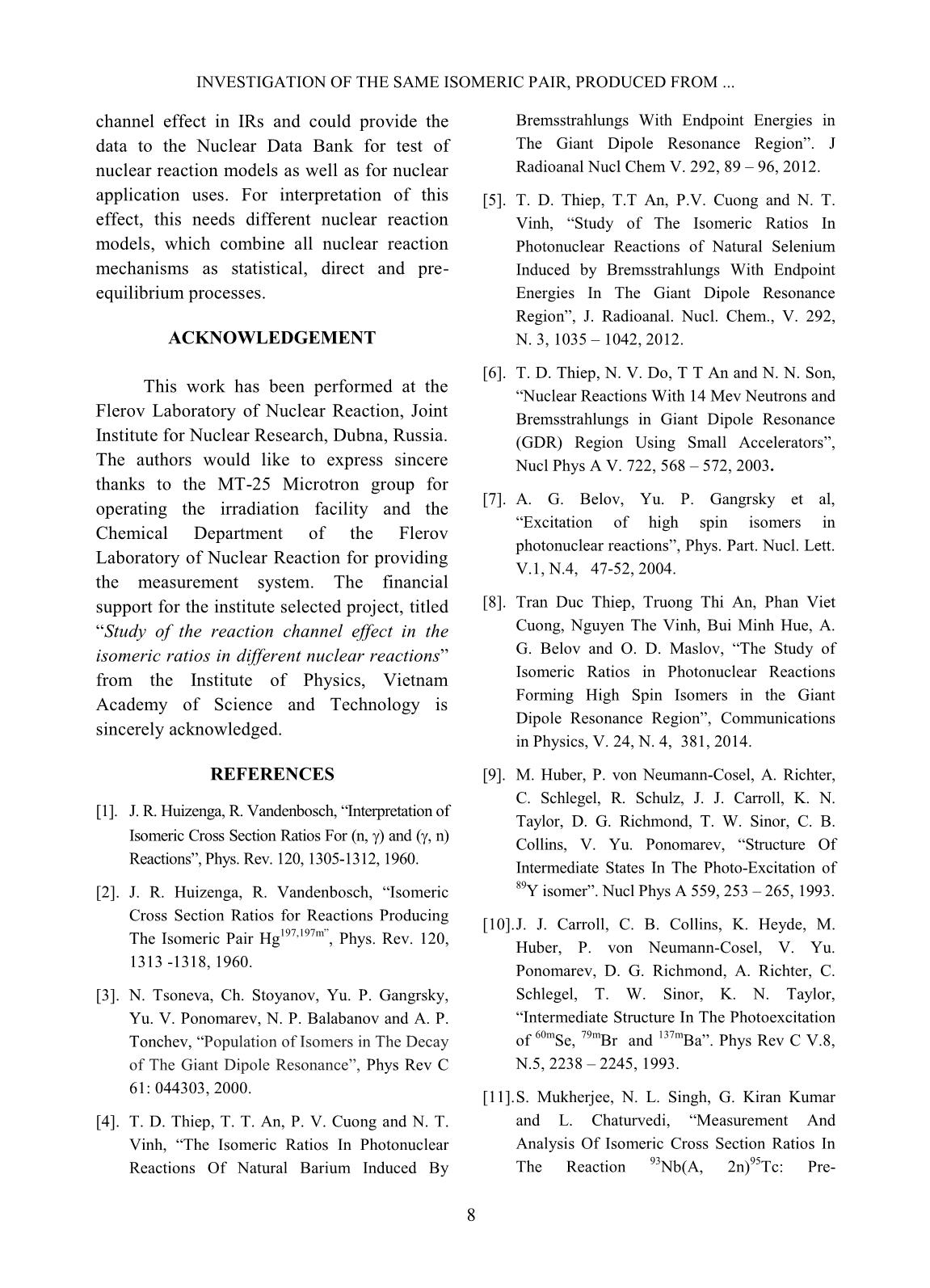
Trang 8
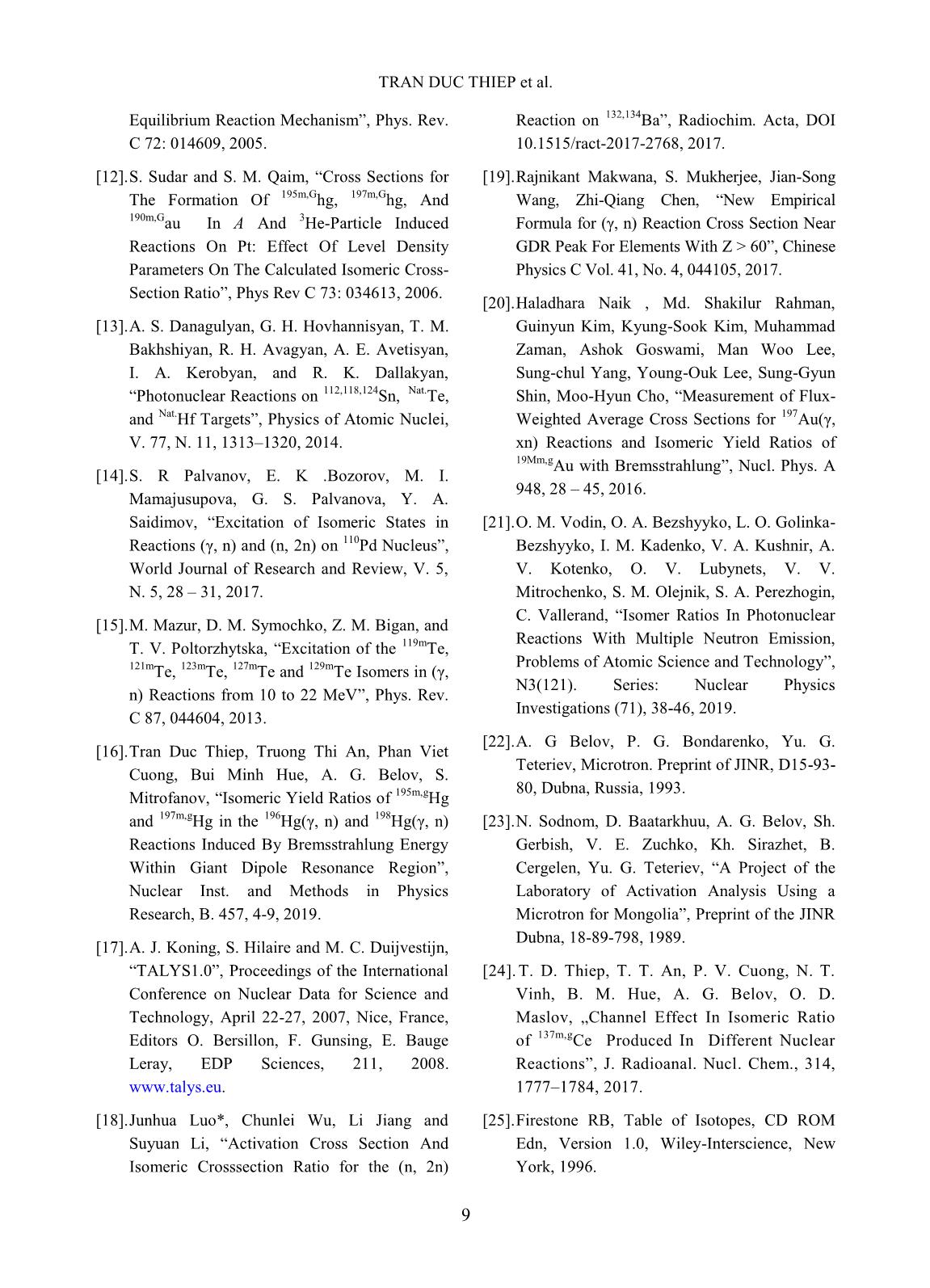
Trang 9
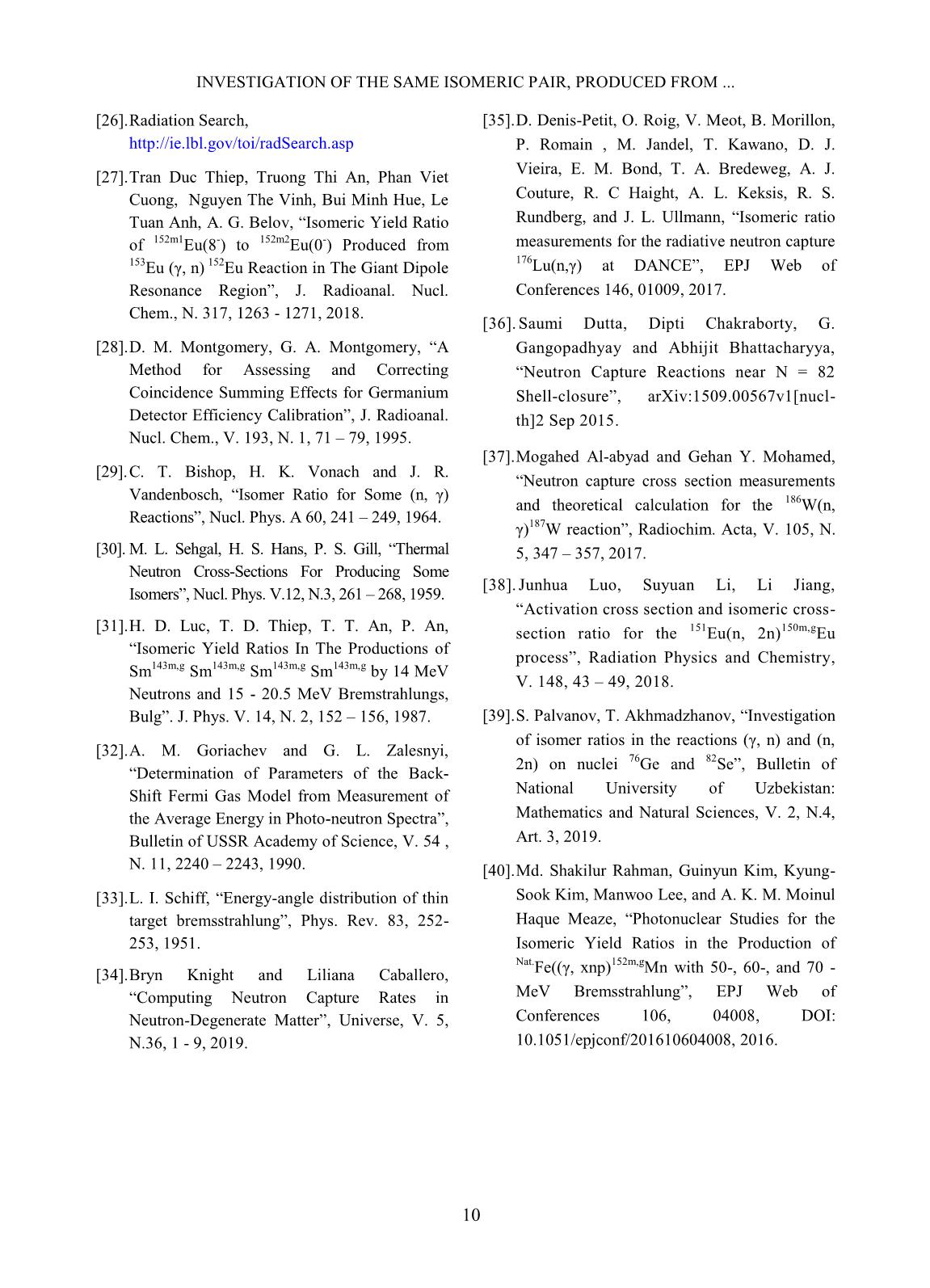
Trang 10
Tóm tắt nội dung tài liệu: Investigation of the same isomeric pair, produced from different nuclear reactions
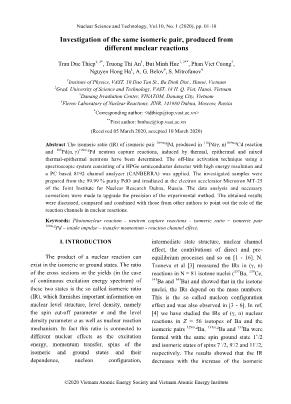
Pd(n, γ)109m,gPd neutron capture reactions, the product excitation energy is equal to the binding energy of 109 Pd, taken from [25]. The product excitation energy of 110 Pd(γ, n)109Pd reaction is an effective value Eeff due to the reaction with bremsstrahlung and was calculated as following: Eeff = Eex - Bn - Ɛn (4) (5) Where Bn - The binding energy of neutron, taken from [25], Ɛn – the mean kinetic energy of photo-neutrons, taken from [32], (E) - the excitation function taken from [14] and (E, E0) - the Schiff formula for the bremsstrahlung photon flux described in ref. [33], E0 - the electron energy and Eth - the reaction threshold energy taken from ref. [25]. For (n, 2n) reaction, the product excitation energy is as following: Eprod.ex = Eex - S2n (6) Where Eprod.ex, Eex and S2n - the product, the target excitation energies and the two neutrons separation energy of the compound nucleus, which were taken from ref. [25]. From the Table II one can make the following comments: a/ For the neutron capture reactions, our results are insignificantly lower than that in ref. [29] and higher than the data in refs. [30]. This may be since in the previous works, the authors used scintillation detector [29, 30], while in this work we used high resolution HPGe semiconductor detector and the advanced data processing program. b/ The product excitation energies in (γ. n) and (n, γ) reaction are insignificantly TRAN DUC THIEP et al. 7 different, but the IRs in (γ, n) reactions are much higher than that in (n, γ) reactions because the intake impulses in the (γ, n) reactions are higher in the (n, γ) reactions. This fact can be used to explain why the IRs in the (n, 2n) reactions strongly exceed that in the (n, γ) and (γ, n) reactions. c/ In photonuclear reactions in the GDR region and nuclear capture reactions by thermal and resonant neutrons, the transfer momenta to the target nuclei are very low, namely L = 1 and 1/2 ħ, respectively. Therefore, the compound nuclei in both reaction kinds are with spins JC = J0, J0 ± 1 and J0 ± 1/2 respectively. These effects restrict the spin range of excited levels or in other words, they restrict the excitation of high spin states making the value of IR in the photonuclear and thermal and resonant neutron capture reactions lower in comparison with that of other reactions. d/ The investigated results show that the IRs in different nuclear reactions are different and depend on the projectile type, intake impulse, excitation energy, spins of the isomeric and ground states as well as the nuclear reaction mechanisms. This is the channel effect in nuclear reactions. e/ The Talys computation program [17] has been applied to study many problems of nuclear physics, in which study of the cross sections and isomeric ratios in nuclear reactions, produced by different projectiles is one important research direction, for example [17 - 21, 34 - 40] and for test any model it is needed to carried not one, but a series of measurements. Therefore, in this meaning we do hope that our results as additional data can be used for the test of nuclear reaction models by the mentioned program. Table II. The IRs of 109m,g Pd in photonuclear reaction, in neutron capture reactions with thermal, resonant and mixed thermal-resonant neutrons and in other reactions. Nuclear Reaction and Product Type of Projectile Product Exc. Energy, MeV Isomeric Ratio IR 108 Pd(n, γ)109m,gPd Thermal neutron 6.15 0.023 ± 0.002 [This work] 0.028 ± 0.005 [29] 0.018 ± 0.005 [30] 108 Pd(n, γ)109m,gPd Resonant neutron 6.15 0.023 ± 0.002 [This work] 0.028 ± 0.005 [29] 108 Pd(n, γ)109m,gPd Mixed Thermal- Resonant neutron 6.15 0.023 ± 0.002 [This work] 110 Pd(γ, n)109m,gPd 24 MeV Bremstrahlung 25 MeV Bremsstrahlung 6.50 6.93 0.069 ± 0.007 [This work] 0.065 ± 0.003 [14] 110 Pd(n, 2n) 109m,g Pd 14.1 MeV neutron 5.28 0.410 ± 0.039 [14] 0.41 ± 0.03 [31] V. CONCLUSIONS We have studied the IRs of the same isomeric pair 109m,g Pd, formed from the photonuclear reaction, neutron capture reactions, induced by thermal, resonant and mixed thermal-resonant neutrons. The obtained results show the nuclear reaction INVESTIGATION OF THE SAME ISOMERIC PAIR, PRODUCED FROM ... 8 channel effect in IRs and could provide the data to the Nuclear Data Bank for test of nuclear reaction models as well as for nuclear application uses. For interpretation of this effect, this needs different nuclear reaction models, which combine all nuclear reaction mechanisms as statistical, direct and pre- equilibrium processes. ACKNOWLEDGEMENT This work has been performed at the Flerov Laboratory of Nuclear Reaction, Joint Institute for Nuclear Research, Dubna, Russia. The authors would like to express sincere thanks to the MT-25 Microtron group for operating the irradiation facility and the Chemical Department of the Flerov Laboratory of Nuclear Reaction for providing the measurement system. The financial support for the institute selected project, titled “Study of the reaction channel effect in the isomeric ratios in different nuclear reactions” from the Institute of Physics, Vietnam Academy of Science and Technology is sincerely acknowledged. REFERENCES [1]. J. R. Huizenga, R. Vandenbosch, “Interpretation of Isomeric Cross Section Ratios For (n, ) and (, n) Reactions”, Phys. Rev. 120, 1305-1312, 1960. [2]. J. R. Huizenga, R. Vandenbosch, “Isomeric Cross Section Ratios for Reactions Producing The Isomeric Pair Hg 197,197m” , Phys. Rev. 120, 1313 -1318, 1960. [3]. N. Tsoneva, Ch. Stoyanov, Yu. P. Gangrsky, Yu. V. Ponomarev, N. P. Balabanov and A. P. Tonchev, “Population of Isomers in The Decay of The Giant Dipole Resonance”, Phys Rev C 61: 044303, 2000. [4]. T. D. Thiep, T. T. An, P. V. Cuong and N. T. Vinh, “The Isomeric Ratios In Photonuclear Reactions Of Natural Barium Induced By Bremsstrahlungs With Endpoint Energies in The Giant Dipole Resonance Region”. J Radioanal Nucl Chem V. 292, 89 – 96, 2012. [5]. T. D. Thiep, T.T An, P.V. Cuong and N. T. Vinh, “Study of The Isomeric Ratios In Photonuclear Reactions of Natural Selenium Induced by Bremsstrahlungs With Endpoint Energies In The Giant Dipole Resonance Region”, J. Radioanal. Nucl. Chem., V. 292, N. 3, 1035 – 1042, 2012. [6]. T. D. Thiep, N. V. Do, T T An and N. N. Son, “Nuclear Reactions With 14 Mev Neutrons and Bremsstrahlungs in Giant Dipole Resonance (GDR) Region Using Small Accelerators”, Nucl Phys A V. 722, 568 – 572, 2003. [7]. A. G. Belov, Yu. P. Gangrsky et al, “Excitation of high spin isomers in photonuclear reactions”, Phys. Part. Nucl. Lett. V.1, N.4, 47-52, 2004. [8]. Tran Duc Thiep, Truong Thi An, Phan Viet Cuong, Nguyen The Vinh, Bui Minh Hue, A. G. Belov and O. D. Maslov, “The Study of Isomeric Ratios in Photonuclear Reactions Forming High Spin Isomers in the Giant Dipole Resonance Region”, Communications in Physics, V. 24, N. 4, 381, 2014. [9]. M. Huber, P. von Neumann-Cosel, A. Richter, C. Schlegel, R. Schulz, J. J. Carroll, K. N. Taylor, D. G. Richmond, T. W. Sinor, C. B. Collins, V. Yu. Ponomarev, “Structure Of Intermediate States In The Photo-Excitation of 89 Y isomer”. Nucl Phys A 559, 253 – 265, 1993. [10]. J. J. Carroll, C. B. Collins, K. Heyde, M. Huber, P. von Neumann-Cosel, V. Yu. Ponomarev, D. G. Richmond, A. Richter, C. Schlegel, T. W. Sinor, K. N. Taylor, “Intermediate Structure In The Photoexcitation of 60m Se, 79m Br and 137m Ba”. Phys Rev C V.8, N.5, 2238 – 2245, 1993. [11]. S. Mukherjee, N. L. Singh, G. Kiran Kumar and L. Chaturvedi, “Measurement And Analysis Of Isomeric Cross Section Ratios In The Reaction 93 Nb(Α, 2n)95Tc: Pre- TRAN DUC THIEP et al. 9 Equilibrium Reaction Mechanism”, Phys. Rev. C 72: 014609, 2005. [12]. S. Sudar and S. M. Qaim, “Cross Sections for The Formation Of 195m,G hg, 197m,G hg, And 190m,G au In Α And 3He-Particle Induced Reactions On Pt: Effect Of Level Density Parameters On The Calculated Isomeric Cross- Section Ratio”, Phys Rev C 73: 034613, 2006. [13]. A. S. Danagulyan, G. H. Hovhannisyan, T. M. Bakhshiyan, R. H. Avagyan, A. E. Avetisyan, I. A. Kerobyan, and R. K. Dallakyan, “Photonuclear Reactions on 112,118,124Sn, Nat.Te, and Nat. Hf Targets”, Physics of Atomic Nuclei, V. 77, N. 11, 1313–1320, 2014. [14]. S. R Palvanov, E. K .Bozorov, M. I. Mamajusupova, G. S. Palvanova, Y. A. Saidimov, “Excitation of Isomeric States in Reactions (γ, n) and (n, 2n) on 110Pd Nucleus”, World Journal of Research and Review, V. 5, N. 5, 28 – 31, 2017. [15]. M. Mazur, D. M. Symochko, Z. M. Bigan, and T. V. Poltorzhytska, “Excitation of the 119mTe, 121m Te, 123m Te, 127m Te and 129m Te Isomers in (γ, n) Reactions from 10 to 22 MeV”, Phys. Rev. C 87, 044604, 2013. [16]. Tran Duc Thiep, Truong Thi An, Phan Viet Cuong, Bui Minh Hue, A. G. Belov, S. Mitrofanov, “Isomeric Yield Ratios of 195m,gHg and 197m,g Hg in the 196Hg(γ, n) and 198Hg(γ, n) Reactions Induced By Bremsstrahlung Energy Within Giant Dipole Resonance Region”, Nuclear Inst. and Methods in Physics Research, B. 457, 4-9, 2019. [17]. A. J. Koning, S. Hilaire and M. C. Duijvestijn, “TALYS1.0”, Proceedings of the International Conference on Nuclear Data for Science and Technology, April 22-27, 2007, Nice, France, Editors O. Bersillon, F. Gunsing, E. Bauge Leray, EDP Sciences, 211, 2008. www.talys.eu. [18]. Junhua Luo*, Chunlei Wu, Li Jiang and Suyuan Li, “Activation Cross Section And Isomeric Crosssection Ratio for the (n, 2n) Reaction on 132,134 Ba”, Radiochim. Acta, DOI 10.1515/ract-2017-2768, 2017. [19]. Rajnikant Makwana, S. Mukherjee, Jian-Song Wang, Zhi-Qiang Chen, “New Empirical Formula for (γ, n) Reaction Cross Section Near GDR Peak For Elements With Z > 60”, Chinese Physics C Vol. 41, No. 4, 044105, 2017. [20]. Haladhara Naik , Md. Shakilur Rahman, Guinyun Kim, Kyung-Sook Kim, Muhammad Zaman, Ashok Goswami, Man Woo Lee, Sung-chul Yang, Young-Ouk Lee, Sung-Gyun Shin, Moo-Hyun Cho, “Measurement of Flux- Weighted Average Cross Sections for 197 Au(γ, xn) Reactions and Isomeric Yield Ratios of 19Mm,g Au with Bremsstrahlung”, Nucl. Phys. A 948, 28 – 45, 2016. [21]. O. M. Vodin, O. A. Bezshyyko, L. O. Golinka- Bezshyyko, I. M. Kadenko, V. A. Kushnir, A. V. Kotenko, O. V. Lubynets, V. V. Mitrochenko, S. M. Olejnik, S. A. Perezhogin, C. Vallerand, “Isomer Ratios In Photonuclear Reactions With Multiple Neutron Emission, Problems of Atomic Science and Technology”, N3(121). Series: Nuclear Physics Investigations (71), 38-46, 2019. [22]. A. G Belov, P. G. Bondarenko, Yu. G. Teteriev, Microtron. Preprint of JINR, D15-93- 80, Dubna, Russia, 1993. [23]. N. Sodnom, D. Baatarkhuu, A. G. Belov, Sh. Gerbish, V. E. Zuchko, Kh. Sirazhet, B. Cergelen, Yu. G. Teteriev, “A Project of the Laboratory of Activation Analysis Using a Microtron for Mongolia”, Preprint of the JINR Dubna, 18-89-798, 1989. [24]. T. D. Thiep, T. T. An, P. V. Cuong, N. T. Vinh, B. M. Hue, A. G. Belov, O. D. Maslov, „Channel Effect In Isomeric Ratio of 137m,g Ce Produced In Different Nuclear Reactions”, J. Radioanal. Nucl. Chem., 314, 1777–1784, 2017. [25]. Firestone RB, Table of Isotopes, CD ROM Edn, Version 1.0, Wiley-Interscience, New York, 1996. INVESTIGATION OF THE SAME ISOMERIC PAIR, PRODUCED FROM ... 10 [26]. Radiation Search, [27]. Tran Duc Thiep, Truong Thi An, Phan Viet Cuong, Nguyen The Vinh, Bui Minh Hue, Le Tuan Anh, A. G. Belov, “Isomeric Yield Ratio of 152m1 Eu(8 - ) to 152m2 Eu(0 - ) Produced from 153 Eu (γ, n) 152Eu Reaction in The Giant Dipole Resonance Region”, J. Radioanal. Nucl. Chem., N. 317, 1263 - 1271, 2018. [28]. D. M. Montgomery, G. A. Montgomery, “A Method for Assessing and Correcting Coincidence Summing Effects for Germanium Detector Efficiency Calibration”, J. Radioanal. Nucl. Chem., V. 193, N. 1, 71 – 79, 1995. [29]. C. T. Bishop, H. K. Vonach and J. R. Vandenbosch, “Isomer Ratio for Some (n, γ) Reactions”, Nucl. Phys. A 60, 241 – 249, 1964. [30]. M. L. Sehgal, H. S. Hans, P. S. Gill, “Thermal Neutron Cross-Sections For Producing Some Isomers”, Nucl. Phys. V.12, N.3, 261 – 268, 1959. [31]. H. D. Luc, T. D. Thiep, T. T. An, P. An, “Isomeric Yield Ratios In The Productions of Sm 143m,g Sm 143m,g Sm 143m,g Sm 143m,g by 14 MeV Neutrons and 15 - 20.5 MeV Bremstrahlungs, Bulg”. J. Phys. V. 14, N. 2, 152 – 156, 1987. [32]. A. M. Goriachev and G. L. Zalesnyi, “Determination of Parameters of the Back- Shift Fermi Gas Model from Measurement of the Average Energy in Photo-neutron Spectra”, Bulletin of USSR Academy of Science, V. 54 , N. 11, 2240 – 2243, 1990. [33]. L. I. Schiff, “Energy-angle distribution of thin target bremsstrahlung”, Phys. Rev. 83, 252- 253, 1951. [34]. Bryn Knight and Liliana Caballero, “Computing Neutron Capture Rates in Neutron-Degenerate Matter”, Universe, V. 5, N.36, 1 - 9, 2019. [35]. D. Denis-Petit, O. Roig, V. Meot, B. Morillon, P. Romain , M. Jandel, T. Kawano, D. J. Vieira, E. M. Bond, T. A. Bredeweg, A. J. Couture, R. C Haight, A. L. Keksis, R. S. Rundberg, and J. L. Ullmann, “Isomeric ratio measurements for the radiative neutron capture 176Lu(n,γ) at DANCE”, EPJ Web of Conferences 146, 01009, 2017. [36]. Saumi Dutta, Dipti Chakraborty, G. Gangopadhyay and Abhijit Bhattacharyya, “Neutron Capture Reactions near N = 82 Shell-closure”, arXiv:1509.00567v1[nucl- th]2 Sep 2015. [37]. Mogahed Al-abyad and Gehan Y. Mohamed, “Neutron capture cross section measurements and theoretical calculation for the 186 W(n, γ)187W reaction”, Radiochim. Acta, V. 105, N. 5, 347 – 357, 2017. [38]. Junhua Luo, Suyuan Li, Li Jiang, “Activation cross section and isomeric cross- section ratio for the 151 Eu(n, 2n) 150m,g Eu process”, Radiation Physics and Chemistry, V. 148, 43 – 49, 2018. [39]. S. Palvanov, T. Akhmadzhanov, “Investigation of isomer ratios in the reactions (γ, n) and (n, 2n) on nuclei 76 Ge and 82 Se”, Bulletin of National University of Uzbekistan: Mathematics and Natural Sciences, V. 2, N.4, Art. 3, 2019. [40]. Md. Shakilur Rahman, Guinyun Kim, Kyung- Sook Kim, Manwoo Lee, and A. K. M. Moinul Haque Meaze, “Photonuclear Studies for the Isomeric Yield Ratios in the Production of Nat. Fe((γ, xnp)152m,gMn with 50-, 60-, and 70 - MeV Bremsstrahlung”, EPJ Web of Conferences 106, 04008, DOI: 10.1051/epjconf/201610604008, 2016.
File đính kèm:
 investigation_of_the_same_isomeric_pair_produced_from_differ.pdf
investigation_of_the_same_isomeric_pair_produced_from_differ.pdf

